北欧绿色邮报网图片报道(记者陈雪霏)--9月30日10点,中国海军护航编队548号护卫舰在斯德哥尔摩国家花园港靠岸,庄严的时刻到了,人们难以抑制激动的心情,五星红旗分外耀眼。
北欧绿色邮报网报道(记者陈雪霏)—— 中国驻瑞典大使陈育明10月2日在出席斯德哥尔摩举办的一场特殊的国庆招待会-“甲板上的约会”时说,中国愿做忠实的和平守护者与世界经济发展的动力源,同国际社会一道共迎挑战,共享机遇,共创未来。
他首先对中国海军护航编队的来访表示热烈欢迎,也对参加甲板上的招待会的中瑞客人表示欢迎。
他说,当今世界新老挑战层出不穷,政局动荡,难民涌入,恐怖袭击,经济下行,金融波动,风浪面前,航海者应该如何应对。我们始终认为,支流无法使和平,发展与合作的时代大潮改向,逆流不能阻挡航船前行。
中国将加深同各国合作实现共同繁荣,共同面对挑战。
他说,中国海军在完成非洲之角亚丁湾的护航任务后首次访问瑞典,带来了真诚的友谊,双边互信增强,也表明了中国保卫世界和平的决心。我们将弘扬中瑞友谊。建交65年来,中瑞并肩行动,建立了一个互利互惠的合作模式,中瑞关系,世界和平与经济发展将迎来阳光明媚的春天。
中国海军护航编队的指挥官王建勋致辞说:今天我们在中国海军军舰上隆重庆祝中华人民共和国成立66周年,暨中国海军152舰艇编队首次访问瑞典。这是个喜庆而值得纪念的日子。66年来,中国完成了从建国初期一穷二白,到现在基本消除贫困,国内人民生活水平明显改善,国际声誉和影响力不断提高,所取得的成就有目共睹。
近年来,通过海上护航,撤离海外公民,应急救援等海外行动,中国海军积极履行负责任大国义务,已经成为一只维护世界和平与稳定的不可或缺的重要力量。中国人民历来热爱和平。
“我们此次来访的目的也正是为了促进和平,传播友谊。”
与此同时,今天也是中瑞建交65周年,中瑞两国虽然相距遥远,但是友好交往历史源远流长,早在18世纪瑞典的哥德堡号航船就曾三次抵达中国,我们现在也期待着更多的哥德堡号驶向东方,驶向中国,驶向太阳升起的地方。
王建勋说,瑞典是第一个同中国建交的国家,是中国的很好的合作伙伴,我们非常珍惜这份友好的情谊。他对瑞典军方的周到安排表示赞赏,这些体现了中瑞之间的深厚感情。他说,在瑞典海军方面的支持下和中国驻瑞典大使馆的支持下,中国海军编队对瑞典的访问是成功的。
瑞典卫生与体育大臣维克斯特伦致辞说:中国是瑞典在亚洲最大的贸易伙伴。中瑞双方贸易合作不断加强。瑞典有500多家公司在中国落户。中国也开始有越来越多的公司在瑞典投资。两国高层互访频繁。今年4月,我也去过北京,南京和上海访问考察推广我们的卫生部门。在健康卫生领域,中瑞可以合作,在研发和绿色科技,生命科学方面都可以加强合作。
出席招待会的还有瑞典国务秘书萨勒斯特朗德和斯特恩斯特罗姆,瑞典驻华大使馆武官马翔大校,中国大使馆武官徐俊,中国驻瑞大使馆政务参赞李军峰,教育参赞窦春祥,科技参赞程家怡,文化参赞浦正东,领事部主任郭延航,驻瑞典各国使节和武官,瑞典华人华侨和中资机构代表等500多人出席了这次别开生面的国庆招待会。
中国海军编队队员为给大家助兴还表演了唢呐和茉莉花。华人歌唱家邹容美等也即兴演唱了《我爱你,中国》,《英雄赞歌》和《军港之夜》令在场的客人感到非常高兴,令华人华侨感到非常激动。
中国海军护航编队于30日从芬兰抵达瑞典进行为期5天的访问。昨天他们还邀请瑞典海军到船上进行联欢。3日将对公众开放,人们可以登上甲板参观。中国海军护航编队是在完成亚丁湾的护航任务之后直接进行环球访问的。他们将在七大洲四大洋环行5个多月。
北欧绿色邮报网报道(记者陈雪霏)--经南京大学校友总会批准,南大北欧校友会10月1日在瑞典首都斯德哥尔摩召开成立大会。
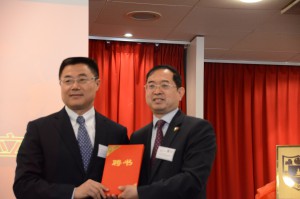
南京大学副校长薛海林一行专程前来出席成立大会并向北欧校友会会长颁发了证书。
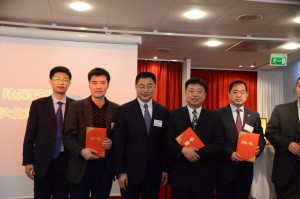 2015年是中瑞、中丹、中芬等北欧国家与中国建交65周年。南大校友会的成立为加强中国与北欧地区的合作增添了新的色彩。南京大学和其他江苏高校在北欧的校友、在瑞华人华侨、中资企业代表等共70余人出席了成立大会。
2015年是中瑞、中丹、中芬等北欧国家与中国建交65周年。南大校友会的成立为加强中国与北欧地区的合作增添了新的色彩。南京大学和其他江苏高校在北欧的校友、在瑞华人华侨、中资企业代表等共70余人出席了成立大会。
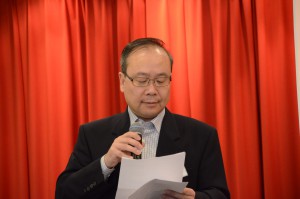 据陈强校友介绍,南大北欧校友会在2012年就开始筹备,期间举行了四五次会议。今天终于正式成立了。其领导成员为:赵幸生,为南京大学北欧校友会首任会长。班艺舫,杨驰,姚炳兴和刘仲华为副会长,陈强为秘书长,王逊为副秘书长。顾群为法律顾问。
据陈强校友介绍,南大北欧校友会在2012年就开始筹备,期间举行了四五次会议。今天终于正式成立了。其领导成员为:赵幸生,为南京大学北欧校友会首任会长。班艺舫,杨驰,姚炳兴和刘仲华为副会长,陈强为秘书长,王逊为副秘书长。顾群为法律顾问。
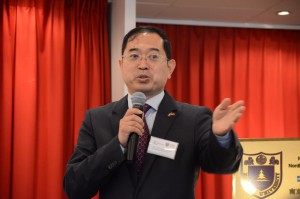 赵幸生表示,感谢校友们的信任,决心努力履行责任,完成好大任。
赵幸生表示,感谢校友们的信任,决心努力履行责任,完成好大任。
中国驻瑞典大使馆文化参赞浦正东,瑞中合作委员会的比约克,中资代表中国银行斯德哥尔摩分行行长郝连才,瑞京华人协会会长柳少惠等致辞祝贺。
五矿总经理李洪中,民航办事处总经理朱津川,瑞典东省政府代表斯特恩先生,两湖同乡会会长刘芳, 华人工商联秘书长张静,中欧文化协会会长陈雪霏,天津人联合会会长宗金波等出席了成立大会。
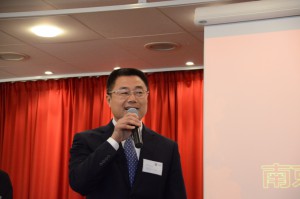 薛海林副校长致辞说,今年是南京大学成立113周年,南京大学已经有30万校友分布在世界各地,有100多个校友会。他希望校友会的工作要与学校的工作重点相结合,起到助推发展的作用。校以校友贵,他希望南京校友会能够发挥更大的作用。
薛海林副校长致辞说,今年是南京大学成立113周年,南京大学已经有30万校友分布在世界各地,有100多个校友会。他希望校友会的工作要与学校的工作重点相结合,起到助推发展的作用。校以校友贵,他希望南京校友会能够发挥更大的作用。
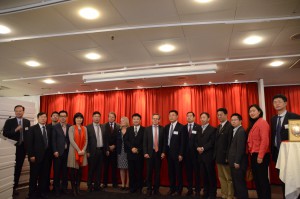 据了解,南京大学是一所历史悠久、声誉卓著的百年名校,是国家“985工程”重点支持的大学。近年来,南大不断加强国际交流与合作,2010年南大成立了中国北欧文化中心,与北欧地区的合作节节升温。目前,南京大学在瑞典的主要合作院校为瑞典皇家理工学院、瑞典林雪平大学、瑞典乌普萨拉大学和瑞典斯德哥尔摩大学。此次薛海林副校长将与北欧最古老的大学乌普萨拉大学校长签署合作备忘录,进一步加强两校之间的合作。
据了解,南京大学是一所历史悠久、声誉卓著的百年名校,是国家“985工程”重点支持的大学。近年来,南大不断加强国际交流与合作,2010年南大成立了中国北欧文化中心,与北欧地区的合作节节升温。目前,南京大学在瑞典的主要合作院校为瑞典皇家理工学院、瑞典林雪平大学、瑞典乌普萨拉大学和瑞典斯德哥尔摩大学。此次薛海林副校长将与北欧最古老的大学乌普萨拉大学校长签署合作备忘录,进一步加强两校之间的合作。
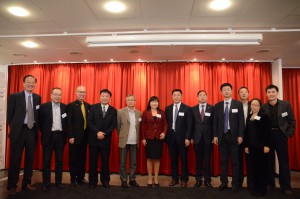 目前,乌普萨拉大学每年派遣地球科学系一位教师(林耐学者)来南京大学工作三个星期,参与本科教学工作和科研活动,派两位本科四年级学生(林耐学生)在南京大学学习20周,学习本科课程并通过参与科学研究完成一份研究报告。同时,南京大学每年派教师一人(帕尔姆学者)来乌普萨拉大学工作三个星期,另派低年级研究生两人(帕尔姆学生)在乌普萨拉大学学习20周,包括两门课程的学习和参与科研工作。此外,本项目还支持为管理目的而进行的双方项目负责人互访。在过去的4年里通过学校领导、师生的互访,两校的合作正在务实稳步地展开。
目前,乌普萨拉大学每年派遣地球科学系一位教师(林耐学者)来南京大学工作三个星期,参与本科教学工作和科研活动,派两位本科四年级学生(林耐学生)在南京大学学习20周,学习本科课程并通过参与科学研究完成一份研究报告。同时,南京大学每年派教师一人(帕尔姆学者)来乌普萨拉大学工作三个星期,另派低年级研究生两人(帕尔姆学生)在乌普萨拉大学学习20周,包括两门课程的学习和参与科研工作。此外,本项目还支持为管理目的而进行的双方项目负责人互访。在过去的4年里通过学校领导、师生的互访,两校的合作正在务实稳步地展开。
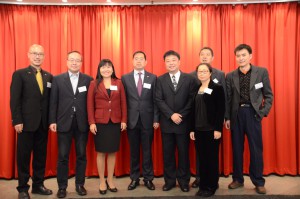 另外,南大和北欧的挪威奥斯陆大学,丹麦哥本哈根大学,芬兰赫尔辛基大学都有交流关系,和东芬兰大学还建立有中芬国际环境科学联合研究中心并已开始运行。
另外,南大和北欧的挪威奥斯陆大学,丹麦哥本哈根大学,芬兰赫尔辛基大学都有交流关系,和东芬兰大学还建立有中芬国际环境科学联合研究中心并已开始运行。
南京大学访问团成员还包括左成慈,贺云翔,刘立阳,孔剑锋和骆威。
图/文 北欧绿色邮报网陈雪霏
微信 chenxuefei7
北欧绿色邮报网报道(记者陈雪霏)——9月30日斯德哥尔摩天气非常晴朗。中国的五星红旗和瑞典的黄蓝国旗在斯旅森码头迎风飘扬。欢迎中国海军护航编队的瑞典侨学商各界人事早早地就在码头上等待迎接!
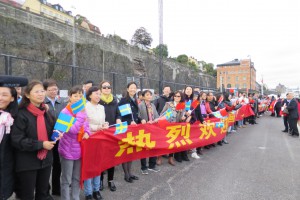 十点钟,中国海军护航编队舷号548的益阳号导弹护卫舰首先靠岸。中国驻瑞典大使陈育明和瑞典驻华大使馆武官徐俊,瑞典海军少将格伦德韦克首先上前迎接!
十点钟,中国海军护航编队舷号548的益阳号导弹护卫舰首先靠岸。中国驻瑞典大使陈育明和瑞典驻华大使馆武官徐俊,瑞典海军少将格伦德韦克首先上前迎接!
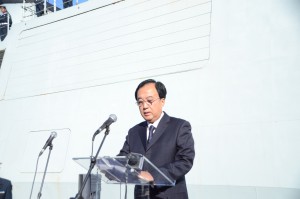 中国驻瑞典大使陈育明首先在欢迎仪式上致辞说:“今天是个喜庆的日子, 在国庆66周年前夕,中国海军护航编队,在圆满完成亚丁湾护航任务后首次访问瑞典,我代表使馆对他们表示热烈欢迎。
中国驻瑞典大使陈育明首先在欢迎仪式上致辞说:“今天是个喜庆的日子, 在国庆66周年前夕,中国海军护航编队,在圆满完成亚丁湾护航任务后首次访问瑞典,我代表使馆对他们表示热烈欢迎。
他说:今年是中瑞建交65周年,海军编队的来访是建交庆祝活动的亮点, 是两国政治互信增强,两军关系深入发展,两国人民情谊深化的真实写照。
“中华民族历来爱好和平,2008年以来,中国先后开出20批海军编队,出色地完成了护航救援任务,为维护国际航道的安全畅通作出了重要贡献。中国将坚持和平发展道路,坚定不移地维护世纪和平,促进共同繁荣。祝愿中国海军编队访问成功“。
中国海军护航编队指挥员,东海舰队副参谋长王建勋发表讲话说:今天我非常高兴,率领中国第20批海军编队来到瑞典首都斯德哥尔摩进行友好访问。今年是中瑞建交65周年,值此良机,中国海军舰队编队首次访问瑞典,可以说是两国海军交往史上的一件盛事,为安排好此次编队首访,瑞典海军,中国驻瑞典大使馆各位领导,以及此次前来欢迎的各界朋友们,在前期进行了大量准备工作,借此机会,我代表编队全体官兵,对大家的深情厚意和辛勤付出,表示衷心的感谢。
他说瑞典是第一个与中国建交的西方国家,建交后,在双方的共同努力下,两国友好合作关系不断深化,各领域交流合作富有成效,特别是近年来,两国领导人互访不断增多,民间交流愈发频繁。
“在此背景下,两国海军的交往不断深入,高层互访不断加强,此次我第20批海军护航编队满载着中国人民和海军的深情厚谊来到这里进行友好访问,我们将与瑞方开展高层拜会,参观军舰,文体交流等丰富而多层次的互动。我们的舰艇还将对瑞典市民开放。希望两国海军以此访为契机,通过这些面对面的密切接触,进一步增进了解与互信,中瑞两国海军的友好交流与合作在此次访问后,一定会有更美好的未来。”
他说,今天有非常好的天气,这预示着这次访问开端是非常顺利的,他也相信,在瑞典海军的精心安排下,此次访问一定能取得圆满成功。
瑞典海军代表格伦德维克少将在欢迎仪式上对152护航编队表示欢迎。
“这对中国海军是历史性的日子,对瑞典海军也同样是历史性的日子。今天既是中国海军第一次来瑞典访问,也是中国的国庆节到来之际,还是中瑞建交65周年之际。”
他说,中瑞都有为联合国维和任务做贡献的传统。说到此时,我们在索马里并肩作战,在印度洋保证海岸线的安全,共同打击海盗。
中瑞之间的历史可以追溯到400多年前,瑞典的商船到中国去做贸易。中国海军这次访问表明我们的关系非常重要。我在18个月前在韩国执行任务期间访问过中国,中国的文化,历史和他们要发展的决心都给我留下深刻的印象。
 欢迎仪式结束后,人们还登船参观。随后,152号济南号导弹驱逐舰也靠着548号护卫舰停泊下来。然后,补给舰也在附近停了下来。
欢迎仪式结束后,人们还登船参观。随后,152号济南号导弹驱逐舰也靠着548号护卫舰停泊下来。然后,补给舰也在附近停了下来。
 欢迎仪式也吸引了很多中外记者。其中有瑞典晚报记者林德。他在接受北欧绿色邮报记者采访时表示:中国海军舰艇的访问非常重要,因为中瑞之间需要更深的互相交流。海军访问就是说“问候”的一种方式。
欢迎仪式也吸引了很多中外记者。其中有瑞典晚报记者林德。他在接受北欧绿色邮报记者采访时表示:中国海军舰艇的访问非常重要,因为中瑞之间需要更深的互相交流。海军访问就是说“问候”的一种方式。
前来迎接的瑞典侨学商界人事都表示非常震撼,非常激动,非常高兴和自豪。
大老远赶来的潮州同乡会会长曾庆平说,“很激动,我们等了几十年了,终于等到了今天。中国强盛起来了。很开心,希望能维持长久。中国时代到来了。”
瑞典华人餐饮协会会长吴俊博也谈了他的感想:“今天感到很自豪,我们中国军事实力增强,祖国强大,我们在国外感到很自豪。舰长正好都是浙江老乡,作为温州人,我也感到自豪,感到激动。”
 中文老师代表岳长顺激动地说,我感到很振奋,一大早儿不到九点就来了,站在高坡上远远地眺望着,等待了一个小时,终于看到祖国的舰队过来了,很高兴,很振奋。
中文老师代表岳长顺激动地说,我感到很振奋,一大早儿不到九点就来了,站在高坡上远远地眺望着,等待了一个小时,终于看到祖国的舰队过来了,很高兴,很振奋。
瑞典皇家科技大学的留学生代表张弛说:我们今天大概早上8点就到了,我们很高兴来参加这次欢迎活动,因为我们自己的军舰航行了这么多个国家。航行这么远的距离,来到瑞典,我们作为在这边的留学生,也是觉得特别的开心。一个是国力的提升,还有跟这么多国家的友好相处,所以大家才能在瑞典的海面上见到中国的军舰。我觉得非常自豪。非常开心,看到很多年轻的士兵在以他们的方式报效祖国,我明年毕业,希望能回国为祖国作出自己的贡献。
北欧中国可持续发展协会会长张寿廷在谈他的感受时说:很激动,也很感动。因为这是中国军舰第一次过来,亲自登上这艘军舰,确实是很激动。我一直关注中国军事实力的增长,从最开始的星星之火可以燎原,到朝鲜战争,到西沙海战,这是我第二次登上中国军舰,西沙海战时,我们的巡逻艇还很小,和那时比,现在的变化非常大。所以我也很感动。
华联秘书长张世瑾说:我今天能来参加这个活动,真是非常高兴,因为我父母也是军人。所以我从小就有军人情节。尤其上了这艘军舰以后,有一种感觉,有一种回到家的感。去年年底,我到夏威夷参观了二战的美国军舰,我上去以后,没什么感觉。但今天,上到我们的军舰,我立即有家的感觉,我感觉特别自豪!尤其是第一次三艘军舰开到我们的岸边,好多人都在山顶上看,觉得特别自豪。
这是中国海军舰艇首次在远离本土执行为期4个月的远海护航行动后,直接转入环球访问任务。
这是中国海军舰艇编队又一次历史性访问。编队已经跨越印度洋、大西洋、太平洋,走进地中海、波罗的海,还要到加勒比海,穿越苏伊士运河、基尔运河、巴拿马运河等重要国际水道,访问苏丹、埃及、丹麦、芬兰、瑞典、波兰、葡萄牙、美国、古巴、墨西哥、澳大利亚、东帝汶、印尼等国家,历时5个多月,总航程3万多海里。
法国著名作家儒勒.凡尔纳写过科幻小说《海底两万里》。如今这些幻想都已经实现。而中国海军实现这个幻想更让人感到自豪。
大部分照片由丹妮拍摄。
资料介绍:舰艇简介:
1、“济南”号导弹驱逐舰,舷号152,编队旗舰。
 052C型,是中国海军第三代导弹驱逐舰。排水量6500吨,长156米,宽17米,高41米,乘员280人。采用柴-燃动力,最高航速30节。装备:8部海红旗-9型防空导弹系统、2部鹰击62型反舰导弹系统、1门100毫米舰炮、2门30毫米舰炮、2部324毫米鱼雷发射器,1架直9C型直升机。
052C型,是中国海军第三代导弹驱逐舰。排水量6500吨,长156米,宽17米,高41米,乘员280人。采用柴-燃动力,最高航速30节。装备:8部海红旗-9型防空导弹系统、2部鹰击62型反舰导弹系统、1门100毫米舰炮、2门30毫米舰炮、2部324毫米鱼雷发射器,1架直9C型直升机。
2、“益阳”号导弹护卫舰,舷号548。
054A型,是中国海军主力导弹护卫舰。排水量4400吨,长135米,宽19米,高35米,乘员165人。采用柴-柴动力,最高航速27节。装备:4部海红旗-16型防空导弹系统、2部鹰击83型反舰导弹系统、1门76毫米舰炮、2门30毫米舰炮、2部324毫米鱼雷发射器、2部反潜火箭发射器,1架直9C型直升机。
附通知:
为庆祝中瑞建交65周年,中国人民解放军海军152护航编队在执行亚丁湾护航任务后,将于2015年9月30日至10月4日访问瑞典斯德哥尔摩。这是中国海军舰艇编队首次访问瑞典。为增进中瑞两国人民的相互了解和友谊,中国驻瑞典大使馆与中国海军护航编队将共同举办舰艇开放活动,欢迎各界人士参观。开放时间:10月3日1100-1700,靠泊地址:Stadsgården 160号码头。参观期间,请勿携带任何包,枪支弹药、刀具、液体,不要在舰艇内部拍照及摄像。
北欧绿色邮报网报道(记者陈雪霏)中国海军护航编队30日顺利抵达瑞典首都斯德哥尔摩港口。中国驻瑞典大使陈育明对中国海军护航编队的到来表示热烈地欢迎。
他说,今天是个喜庆的日子, 在国庆66周年前夕,中国海军护航编队,在圆满完成亚丁湾护航任务后首次访问瑞典,
“今年是中瑞建交65周年,海军编队的来访是庆祝建交活动的亮点。 是两国政治互信增强,两军关系深入发展,两国人民情谊深化的真实写照。”
他强调指出,中华民族历来爱好和平,2008年以来,中国先后开出20批海军编队,出色地完成了护航救援任务,为维护国际航道的安全畅通作出了重要贡献。中国将坚持和平发展道路,坚定不移地维护世界和平,促进共同繁荣。
瑞典华人华侨对中国海军护航编队的到来也进行了热烈欢迎。
本网将继续报道
by Xinhua writer Lyu Dong
BEIJING, Sept. 23 (Greenpost) — The rise of several European offshore hubs for the Chinese currency, the renminbi or yuan, has led each to tap their respective strengths to help the “redback” realize its global ambitions.
China’s push for the globalization of its currency has spurred financial centers worldwide to become offshore yuan hubs. In Europe, London, Frankfurt and Luxembourg are among the financial centers in the region vying to help the yuan gain greater acceptance on the continent.
These European financial centers can leverage their unique strengths to help the yuan achieve global use in areas such as foreign exchange trading, settlement and investment, according to Nicolas Mackel, CEO of Luxembourg for Finance, an agency for financial sector development. Mackel is heading an 80-person delegation to visit Beijing, Shanghai and Shenzhen this week to promote Luxembourg as an offshore hub for the yuan.
“Every financial center is specialized in certain areas,” Mackel said.
Luxembourg is making the case that its status as Europe’s asset management hub positions it as an ideal choice for housing yuan-denominated investments, such as funds invested in China’s onshore capital markets and yuan-denominated dim-sum bonds listed on its exchange.
“London is the world’s capital for foreign exchange operation and clearly will also be the case for renminbi trading. Frankfurt, the financial center of Germany, China’s most important trading partner in Europe, will serve as the trade settlement [center] for Renminbi. Luxembourg is one of the world’s leaders for investment funds and international bond listings and the European continental hub for Chinese banks,” Mackel said on Monday.
The Chinese yuan already ranks as the world’s fifth most used currency in payment and second in trade financing, according to the SWIFT. Yet China also wants it to be used among investors and expects more central banks to hold the yuan as reserves.
With nearly 3.5 trillion euro in assets under management, Luxembourg has approved more than 20 mutual funds to invest in China’s stock market using the Shanghai-Hong Kong Stock Connect launched in November. However, yuan-denominated funds domiciled in Luxembourg remain few, currently worth 296 billion yuan.
In April, China granted the Grand Duchy a 50-billion-yuan RQFII quota, which allows foreign institutional investors to invest in China’s onshore capital market using the yuan.
China’s five largest state-owned lenders and China Merchants Bank have all established their European headquarters in Luxembourg, and five out of six Chinese asset managers who opted to launch investment funds in Europe via Hong Kong subsidiaries have chosen the country as a domicile for their funds.
China’s regulators allow foreign participation in the country’s capital markets through the Qualified Foreign Institutional Investors (QFII) scheme, RQFII and a program linking stock exchanges in Shanghai and Hong Kong.
But some foreign institutional investors argue that they face liquidity constraints and a lack of flexibility in investment quota allocation under these schemes. MSCI also cited these among reasons behind its decision to postpone the inclusion of China-listed shares in its widely tracked stock indices in June.
George Osborne, British Chancellor of the Exchequer, also announced this week during his trip to China a feasibility study into linking the London and Shanghai stock markets, potentially adding a new channel for offshore investors to expand their exposure to yuan-denominated securities.
Camille Thommes, director general of the Association of the Luxembourg Fund Industry, told Xinhua that the Luxembourg delegation was scheduled for meetings with China’s securities watchdog, the China Securities Regulatory Commission, and the State Administration of Foreign Exchange on Monday and Tuesday to discuss easing entry for offshore investors to China’s onshore capital market.
He added that interest in expanding exposure to Chinese securities is still high among Luxembourg-domiciled funds despite the volatilities in China’s stock market and the revaluation of the Chinese currency.
“I think these will not affect the fundamental interest in investing in the Chinese capital markets. There is still strong demand from investors who take long-term and positive views on Asian capital markets, specifically China,” Thommes said.
A survey of more than 500 Hong Kong-based investors conducted by Standard Chartered Bank between Aug. 14 to 22, when both China’s stock market and its currency underwent major corrections, also found that more than 70 percent of respondents are still willing to hold and even increase their holdings of yuan-denominated assets.
“Although volatility is certainly an aspect which has to be properly monitored, institutional investors in Europe or the U.S. taking a long term view will have to keep or even increase the weighting of China-related securities in their portfolio,” said Stephane Karolczuk, a lawyer with law firm Arendt & Medernach, which has advised the first Luxembourg mutual fund to use the Shanghai-Hong Kong Stock Connect in investing in Shanghai-traded stocks.
“QFII, RQFII and stock connect will remain very relevant to them.” Karolczuk said.
In addition to housing funds invested in China, Luxembourg’s stock exchange is also the largest listing market for yuan-denominated bonds in Europe and ranks third globally after Hong Kong and Singapore.
So far, issuers of yuan-denominated debts on the exchange are mostly multinational corporations seeking to raise offshore yuan to fund their operations in China, while Chinese issuers are mostly financial institutions. At 51.2 percent, European issuers account for the largest share of issuers that raise yuan at the exchange.
The advantage of listing yuan bonds in Luxembourg, according to Robert Scharfe, CEO of the Luxembourg Stock Exchange, is that its information transparency is unrivalled among dim-sum bond markets globally. Enditem
BEIJING, Sept. 23 (Xinhua) — Trying to restart a slowing economic growth, China’s President Xi Jinping has decided to deepen the reform and open up the country wider to the outside world.
“China will stay strongly committed to deepening its reform on all fronts while opening still wider to the outside world,” Xi told the Wall Street Journal in a written interview before he departed for an official state visit to the United States on Tuesday.
This was the second time in a week that the president reassured the market, that the policies which brought wealth and prosperity to China’s people will continue, deeper and wider.
Last week, Xi told a room of former U.S. officials and business leaders that China is fully committed to reform and opening up and he hoped they would actively support it.
While China and the United States are expecting much from Xi’s visit, China-Britain cooperation has born fruit. On Monday, the two countries reached 53 agreements on nuclear energy, high-speed railway, infrastructure among many others at the 7th China-Britain Economic and Financial Dialogue in Beijing.
Notably, China suggested opening up its closely controlled financial market, allowing British institutional investors to trade securities in China, and mulling a mechanism to connect the Shanghai and London exchanges.
Premier Li Keqiang told visiting British Chancellor of the Exchequer George Osborne that China is ready to cooperate in an open and inclusive manner.
These agreements indicated that opening up has reached levels unthinkable decades ago.
Since the incumbent central leadership was formed in late 2012, China has introduced many new measures to foreign investment and trade.
China is actively seeking a bigger say in international affairs, by participating in and increasingly initiating, global cooperation.
The Asian Infrastructure Investment Bank and the Belt and Road initiative are among China’s efforts to supplement the existing international order and overhaul global governance.
The phrase “opening up” frequently appears in policy statements and headlines at a time when China needs to find new sources of growth.
During a tumultuous summer, Chinese stocks were hit by repeated plunges and most of economic indicators were soft. Worries arose about whether China can sustain medium-to-high speed growth. Reform and opening up is China’s solution. Last week, Xi said opening up and reform will add new impetus and vitality to the economy and provide new room for growth.
“China should be committed to attracting foreign investment and expertise, and improve opening-up policies,” he said, addressing the 16th Meeting of the Central Leading Group for Deepening Overall Reform.
“The government will not change its policy toward foreign investment, and will protect the lawful interests of foreign-funded companies and provide better services for them,” said a statement released after the meeting.
China promised to make a national “negative list” by 2018, of sectors which are not fully open to all market entities, both domestic and overseas. Border areas will explore new models of cross-border cooperation and new mechanisms for regional growth.
More state-controlled sectors will be opened to private investors and it will be easier for foreigners to apply for permanent residence permits.
China is becoming more interdependent on and interrelated to the world economy, said John Thornton, co-chair of Washington-based think tank Brookings Institution.
Regional and global cooperation and policy coordination can yield results satisfactory to all, he said.
“China has been on a course of reform and opening up for almost 40 years. That trend will continue,” said Thornton. Enditem
GUANGZHOU, Sept. 23 (Xinhua) — China is preparing a tougher Food Safety Law to come into effect on Oct. 1, said a senior official with China Food and Drug Administration (CFDA) on Tuesday.
Guo Wenqi made the remark at a seminar on food safety and rule of law in Guangzhou, capital city of south China’s Guangdong Province.
In April, the Standing Committee of China’s National People’s Congress (NPC), the country’s top legislature, adopted an amendment to the 2009 Food Safety Law with the heaviest civil, administrative and criminal penalties yet for offenders and their supervisors.
According to Guo Xiaoguang, head of CFDA Bureau of Investigation and Enforcement, the CFDA has been working with a dozen agencies, including financial institutions, taxation and fiscal departments, on dealing with serious food safety violators.
Enterprises that violate the revised law may face restrictions on loans, taxation, bidding and land use. The CFDA will also provide bigger rewards to whistleblowers.
Hua Jingfeng, deputy head of Public Order Administration at the Ministry of Public Security said, “We encourage tip-offs from the public and food industry associations.”
He said the ministry wants trained police specialized in food crime and so far 21 provincial public security departments have set up food safety teams.
Guan Yingshi from the SPC said people’s courts are taking measures to promote public awareness of food safety law. For example, trials of some notorious food crimes will be on live broadcast.
The Supreme People’s Procuratorate will take action over neglect of duty in food production as well as safety supervision.
“By analyzing the underlying causes of the cases through investigations and trials and drawing lesson from them, the SPP will be able to give advice and help businesses set up regulations and fix loopholes,” said Huo Yapeng of the SPP. Enditem
SHANGHAI, Sept. 22 (Xinhua) — Media and entertainment investment fund China Media Capital (CMC), together with industry players including Disney, have invested 65 million U.S. dollars in Jaunt, a company pioneering cinematic virtual reality (VR).
The deal will give Jaunt resources to create more content and innovate in VR filmmaking, said CMC in a statement on Tuesday.
The series C round of funding will greatly expand Jaunt’s global reach, helping make VR the next mainstream content medium, it added.
There is much room for VR technology to be applied in film, television, games, sports, and mobile media, according to the statement.
In recent years, advances in technology and mobile devices have made fully-immersive VR possible and accessible to the masses.
CMC was founded in 2010 as China’s first private equity fund for financing media companies, with an initial fund of 2 billion yuan (314 million U.S. dollars). Enditem
BEIJING, Sept. 23 (Xinhua) — A consortium of Chinese and Indian companies will conduct a feasibility study for a high-speed railroad linking New Delhi and Mumbai, China Railway Corporation (CRC) said on Wednesday.
The Third Railway Survey and Design Institute Group Corporation, a subsidiary of CRC, will work with Indian firms, dispatching rail experts to initiate the study for the 1,200-km railway, CRC said.
India has invited global tenders for three high-speed rails, including the New Delhi-Mumbai railway, in December and attracted 12 consortiums from 7 countries bidding for the contracts.
CRC said China’s railway technology is reliable and adaptive and has lower price/performance ratio.
China now has around 17,000 km of fast tracks, accounting for more than 60 percent of the world’s total. Enditem
BEIJING, Sept. 23 (Xinhua) — A numerical simulation prototype system that could one day help predict natural disasters debuted in Beijing on Wednesday, the first of its kind to be made by China.
The current iteration can be used by Chinese scientists to support research into short-term climate prediction, and dust and haze control.
The high-performance prototype, which was developed under the lead of the Institute Atmospheric Physics with the Chinese Academy of Sciences (CAS), is capable of producing a numerical simulation of Earth, and features a support framework and visualization system.
Zhang Minghua, researcher with the institute, said that the prototype system applies features and experience gained from the Earth system model version 1.0, which is used to predict evolution of atmosphere, ocean current, land surface process and ecology.
The State Council, China’s cabinet, in March 2013 urged the scientific community to develop “a numerical simulator of the Earth system.”
This prototype system is the first step toward a full simulator, according to the CAS.
Climate and eco-system changes have become a global scientific problem.
According to statistics with China Meteorological Administration, some 70 percent of all natural disasters are directly related to climate conditions. About 400 million people are affected annually by major climate disasters in China. Enditem